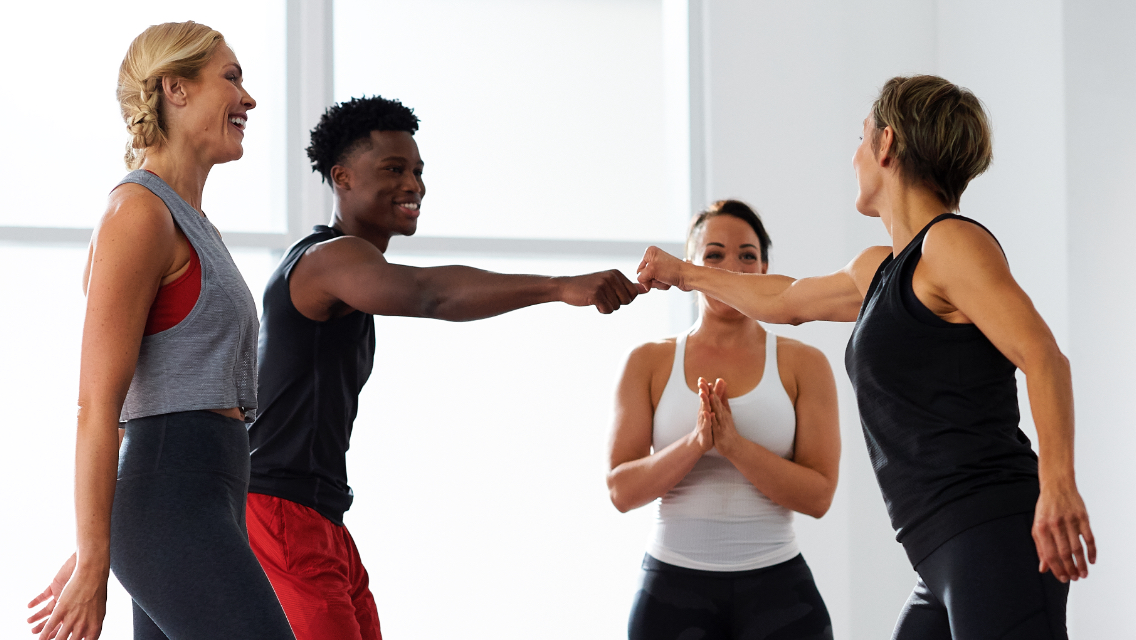In today’s fast-paced lifestyle, maintaining both physical and mental well-being is a challenge many face. This article provides effective strategies through energizing workouts and nutritional approaches aimed at improving mood, enhancing fitness, and promoting overall health. By integrating these techniques into your routine, you can cultivate a sustainable fitness journey that not only boosts your energy levels but also supports your emotional resilience.
Explore the science behind exercise and mood enhancement, discover various types of workouts, and learn how to create a balanced nutritional plan. Additionally, we will cover essential mindset shifts and innovative recovery techniques to help you maximize your performance and maintain long-term success in your fitness endeavors.
In this article you will find:
Energizing Workouts to Boost Your Mood
In today’s fast-paced world, finding ways to elevate our mood and boost our energy levels is essential for maintaining overall well-being. One of the most effective methods to achieve this is through energizing workouts. Not only do these workouts enhance physical fitness, but they also play a crucial role in improving mental health and emotional resilience. Here, we explore various workout strategies designed to uplift your spirits and invigorate your day.
The Science Behind Exercise and Mood Enhancement
Engaging in regular physical activity triggers the release of endorphins, often referred to as the body’s natural mood lifters. These chemicals interact with the receptors in your brain to reduce the perception of pain and induce a positive feeling in the body. Furthermore, exercise can decrease stress hormones such as cortisol, making it a powerful tool for enhancing mood.
Types of Energizing Workouts
Different workouts can provide unique benefits, and incorporating a variety into your routine can keep things fresh and exciting. Here are some energizing workout types that can help lift your mood:
- High-Intensity Interval Training (HIIT): This training method alternates between short bursts of intense activity and rest periods. HIIT is not only efficient for burning calories but also stimulates endorphin production, leading to an immediate mood boost.
- Dance Workouts: Whether it’s Zumba, hip-hop, or ballroom dancing, moving to music can be incredibly uplifting. Dance workouts combine physical activity with social interaction, further enhancing the joy of movement.
- Yoga and Mindfulness Practices: While yoga is often associated with relaxation, certain styles like Vinyasa or Power Yoga can energize the body and mind. The focus on breath and movement helps to clear the mind and elevate mood.
- Outdoor Activities: Engaging in physical activities like hiking, cycling, or jogging outdoors can significantly improve your mood. Exposure to sunlight increases serotonin levels, which can enhance feelings of happiness.
Creating Your Energizing Workout Routine
To effectively integrate energizing workouts into your life, consider the following steps:
- Set Realistic Goals: Start with achievable goals that motivate you. Whether it’s working out three times a week or mastering a new dance routine, small victories will keep you engaged.
- Mix It Up: Variety is key to preventing boredom. Incorporate different types of workouts throughout the week to keep your routine exciting and challenging.
- Find a Workout Buddy: Exercising with a friend can enhance motivation and make workouts more enjoyable. Plus, it adds an element of accountability.
- Listen to Your Body: Pay attention to how your body responds to different workouts. If you feel energized after a session, make it a regular part of your routine. If not, don’t hesitate to switch things up.
Staying Consistent for Long-Term Benefits
The key to reaping the emotional and physical benefits of exercise lies in consistency. Aim to incorporate energizing workouts into your routine at least three to four times a week. Over time, you’ll likely notice not just an improvement in your mood but also enhanced energy levels and overall health.
For more insights on how exercise impacts mental health, you can explore resources from the National Institutes of Health, which delve deeper into the relationship between physical activity and emotional well-being.
Nutritional Strategies for Lasting Health
In the pursuit of lasting health, nutrition plays a pivotal role. The foods we consume not only fuel our bodies but also influence our mood, energy levels, and overall well-being. By adopting effective nutritional strategies, you can create a sustainable approach to eating that supports your fitness goals and enhances your quality of life. Here, we explore key strategies to optimize your nutrition for lasting health.
The Importance of Whole Foods
One of the foundational principles of a healthy diet is to prioritize whole foods. These foods are minimally processed and retain their natural nutrients. Incorporating a variety of whole foods into your diet can significantly improve your health. Here are some examples:
- Fruits and Vegetables: Rich in vitamins, minerals, and antioxidants, these foods help combat oxidative stress and inflammation.
- Whole Grains: Foods like quinoa, brown rice, and whole wheat bread provide essential fiber, which is crucial for digestive health and maintaining steady energy levels.
- Lean Proteins: Sources such as chicken, fish, beans, and legumes support muscle repair and growth, making them essential for active individuals.
- Healthy Fats: Incorporating sources of healthy fats, like avocados, nuts, and olive oil, is important for brain health and hormone regulation.
Balanced Macronutrients for Optimal Energy
A balanced intake of macronutrients—carbohydrates, proteins, and fats—is essential for maintaining energy levels and supporting overall health. Here’s how to achieve a balanced macronutrient profile:
- Carbohydrates: Aim for complex carbohydrates that provide sustained energy. Foods like sweet potatoes, whole grains, and fruits are excellent choices.
- Proteins: Include a source of protein in every meal to support muscle recovery and keep you feeling full. Consider plant-based options like lentils or tofu for variety.
- Fats: Don’t shy away from healthy fats; they are essential for nutrient absorption and hormone production. Nuts, seeds, and fatty fish like salmon are great options.
Mindful Eating Practices
In addition to choosing the right foods, how you eat is equally important. Practicing mindful eating can enhance your relationship with food and promote better digestion. Here are some tips for mindful eating:
- Slow Down: Take time to savor each bite, allowing your body to recognize hunger and fullness cues.
- Limit Distractions: Eating without distractions, such as screens or multitasking, helps you focus on your meal and enjoy it more fully.
- Listen to Your Body: Pay attention to how different foods make you feel, and adjust your diet accordingly to optimize your well-being.
Hydration as a Key Component
Staying hydrated is crucial for overall health and can significantly impact your energy levels and cognitive function. Aim to drink plenty of water throughout the day, and consider the following:
- Incorporate Hydrating Foods: Foods with high water content, such as cucumbers, watermelon, and oranges, can contribute to your hydration needs.
- Monitor Your Intake: A general guideline is to aim for at least eight 8-ounce glasses of water daily, but individual needs may vary based on activity levels and climate.
For further reading on how nutrition impacts health, visit the Choose My Plate website for valuable resources on building a balanced diet.
Mindset Shifts for Sustainable Fitness Success
Achieving sustainable fitness success is as much about the mind as it is about the body. A positive and resilient mindset can be the difference between reaching your goals and falling short. By implementing effective mindset shifts, you can foster a healthy relationship with fitness that promotes long-term success. Here, we explore several key mindset transformations that can help you thrive on your fitness journey.
Embrace the Journey, Not Just the Destination
One of the most common pitfalls in fitness is focusing solely on end results, such as losing a specific amount of weight or achieving a certain level of performance. This can lead to frustration and disappointment if progress seems slow. Instead, shift your focus to embracing the journey. Celebrate small victories along the way, such as completing a challenging workout or improving your stamina.
- Set Process Goals: Instead of only setting outcome goals (like weight loss), establish process goals that focus on the actions you will take. For example, aim to exercise for 30 minutes five times a week.
- Reflect on Progress: Keep a journal to track not just your physical changes, but also your emotional and mental growth. This can provide valuable insights and motivation.
Adopt a Growth Mindset
A growth mindset is the belief that abilities and intelligence can be developed with effort and perseverance. This mindset encourages you to view challenges as opportunities for growth rather than obstacles. Here’s how to cultivate a growth mindset in your fitness routine:
- Learn from Setbacks: Instead of viewing setbacks as failures, see them as learning experiences. Analyze what went wrong and how you can adjust your approach moving forward.
- Seek Feedback: Don’t hesitate to ask for feedback from trainers, friends, or fitness communities. Constructive criticism can help you improve and grow.
Visualize Your Success
Visualization is a powerful tool used by many successful athletes. By picturing yourself achieving your fitness goals, you can strengthen your commitment and motivation. Incorporate visualization into your routine with these strategies:
- Daily Visualization Practice: Spend a few minutes each day visualizing yourself completing a workout or reaching a fitness milestone. Imagine the feelings of accomplishment and joy that come with success.
- Create a Vision Board: Compile images and quotes that represent your fitness goals and aspirations. Place your vision board somewhere visible to remind you of what you’re working towards.
Build a Supportive Community
Your mindset can be significantly influenced by the people around you. Surrounding yourself with a supportive community can help foster a positive outlook on your fitness journey. Consider these approaches:
- Join Fitness Groups: Whether online or in person, connecting with others who share similar goals can provide encouragement and accountability.
- Engage in Social Workouts: Group classes or workout sessions with friends can make exercise more enjoyable and motivate you to stick with it.
Practice Self-Compassion
In the pursuit of fitness, it’s easy to be hard on yourself, especially if you miss a workout or indulge in less healthy foods. Practicing self-compassion can help you maintain a healthier mindset. Here’s how to cultivate self-compassion:
- Be Kind to Yourself: Treat yourself with the same kindness and understanding that you would offer a friend. Acknowledge that everyone has ups and downs on their fitness journey.
- Focus on the Positive: Rather than dwelling on perceived failures, shift your attention to the positive changes you’ve made and the efforts you’ve put in.
For more insights on developing a growth mindset and its impact on fitness, visit the Mindset Works website, which offers resources and tools for cultivating a positive mindset.
Innovative Recovery Techniques for Optimal Performance
In the realm of fitness, recovery is just as crucial as the workouts themselves. Innovative recovery techniques not only help in repairing muscles but also play a vital role in enhancing overall performance. By incorporating modern recovery strategies into your routine, you can optimize your results and minimize the risk of injury. Here are some effective techniques that can elevate your recovery game and support your fitness journey.
Active Recovery Methods
Active recovery involves low-intensity exercise that promotes blood flow and aids in muscle recovery without putting additional strain on the body. Here are some popular active recovery methods:
- Light Aerobic Activities: Engaging in light jogging, cycling, or swimming can help maintain your fitness level while allowing your body to recover.
- Dynamic Stretching: Incorporating dynamic stretches post-workout helps in reducing muscle stiffness and improving flexibility.
- Yoga and Pilates: These practices enhance flexibility, balance, and core strength, making them excellent for active recovery.
Cold and Heat Therapy
Using temperature-based therapies can significantly aid recovery by reducing inflammation and promoting blood flow. Here’s how you can incorporate them:
- Ice Baths and Cold Showers: Cold exposure can reduce muscle soreness and inflammation post-exercise. Consider taking an ice bath or a cold shower for 10-15 minutes after intense workouts.
- Heat Therapy: Applying heat through warm baths, heating pads, or saunas can enhance blood circulation and relax tight muscles, making it ideal for recovery days.
Massage and Myofascial Release
Massage therapy is not only a luxury but also an essential recovery technique that can alleviate muscle tension and improve flexibility. Here are a couple of methods:
- Professional Massage: Regular sessions with a licensed massage therapist can help in identifying and alleviating muscle tightness.
- Foam Rolling: This self-myofascial release technique helps in releasing knots in muscles and improving blood flow. Spend a few minutes rolling out tight areas post-workout.
Nutrition for Recovery
Your diet plays a critical role in recovery. Focusing on nutrient-dense foods can enhance muscle repair and replenish energy stores. Consider these nutritional strategies:
- Protein Intake: Consuming protein-rich foods such as lean meats, eggs, or plant-based proteins immediately after workouts can facilitate muscle repair.
- Hydration: Adequate hydration is essential for recovery. Consider electrolyte-rich drinks post-exercise to replenish lost fluids and minerals.
- Anti-Inflammatory Foods: Incorporating foods rich in omega-3 fatty acids (like salmon and flaxseeds) and antioxidants (like berries and leafy greens) can help reduce inflammation.
Sleep and Recovery
Never underestimate the power of a good night’s sleep. Quality sleep is crucial for physical recovery and overall health. Here’s how to improve your sleep hygiene:
- Establish a Sleep Routine: Go to bed and wake up at the same time each day to regulate your body’s internal clock.
- Create a Relaxing Environment: Ensure your sleep space is dark, quiet, and cool to promote deeper sleep.
- Avoid Screens Before Bed: Limit exposure to screens at least an hour before bedtime to improve sleep quality.
For more comprehensive insights into recovery techniques, consider checking out the National Institutes of Health which provides valuable research on recovery strategies for athletes and active individuals. Incorporating energizing workouts into your routine is crucial for boosting mood and enhancing physical fitness. Key types of workouts include High-Intensity Interval Training (HIIT), dance classes, yoga, and outdoor activities, all of which stimulate endorphin production and improve mental health. To maintain a successful routine, set realistic goals, diversify your workouts, find a workout partner, and stay attuned to your body’s responses.
Nutritional strategies also play a vital role in achieving lasting health. Prioritize whole foods, maintain a balanced intake of macronutrients, practice mindful eating, and ensure proper hydration. Additionally, innovative recovery techniques such as active recovery, temperature therapies, massage, and adequate sleep are essential for optimizing performance and promoting overall well-being. For further insights, resources like the National Institutes of Health and Choose My Plate can provide valuable information on fitness and nutrition.




